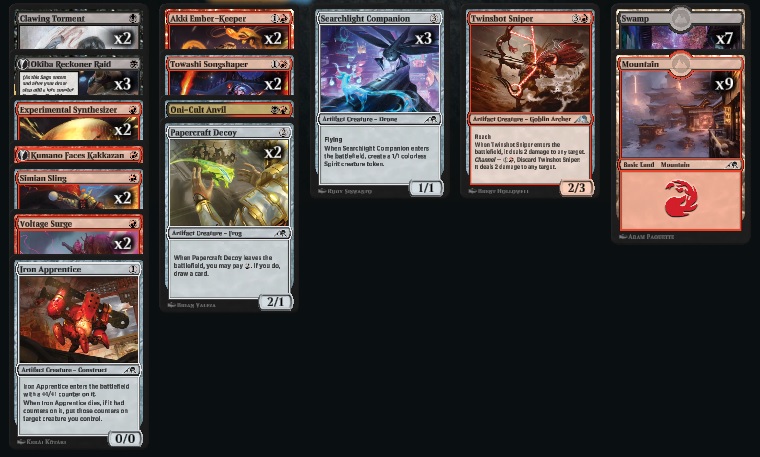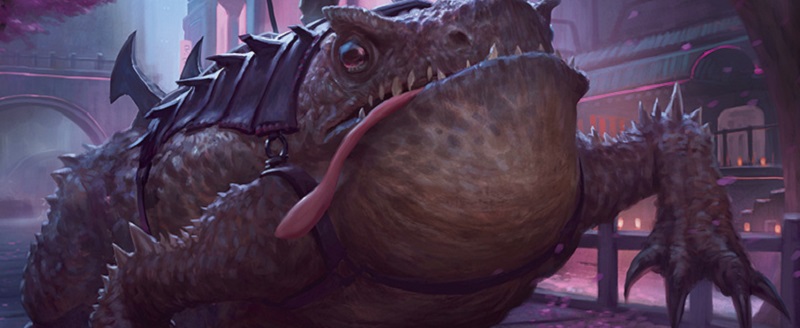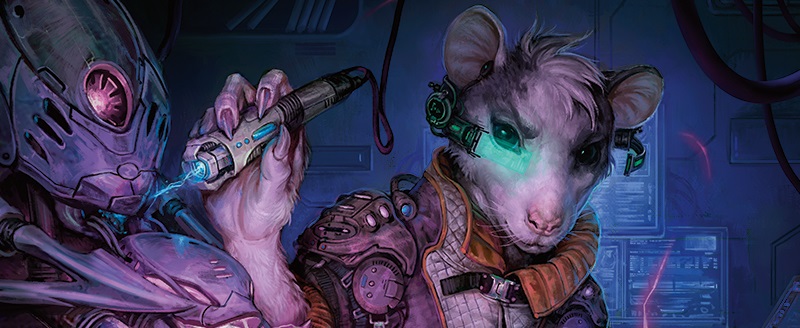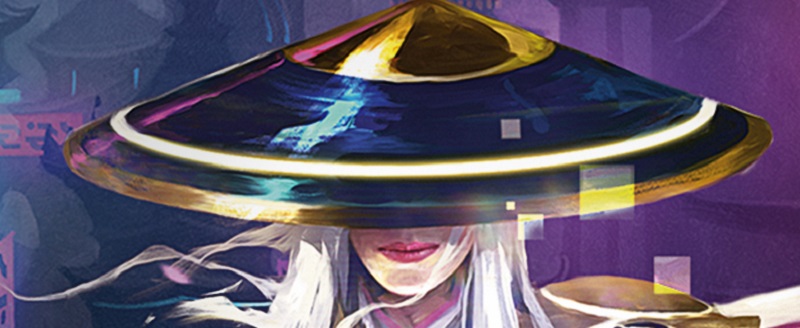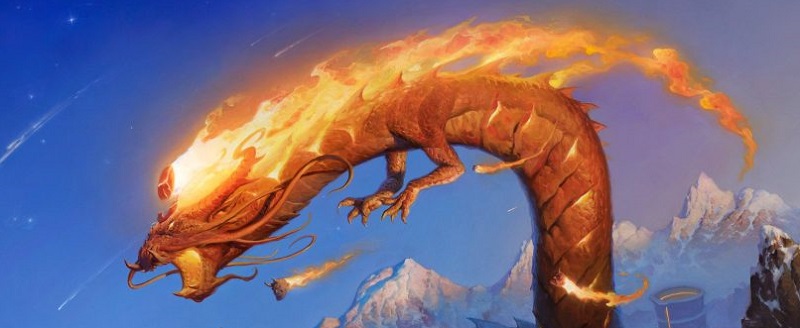Introduction
Looking to crush with Mono Red Aggro in Kamigawa Neon Dynasty? Then look no further than our Archetype Analysis. This NEO draft guide explains the key concepts which make the deck tick, before detailing every crucial card in the archetype. Next we take a look at some powerful rares, traps to avoid and consider the merits of playing Rakdos over Mono Red. Finally we discuss some gameplay points before taking a look at some example decks. Let’s get into it.
Archetype Overview
Mono Red Aggro is an iconic MTG archetype. Often found wreaking havoc in standard, this deck occasionally rears its ugly head in limited, where it can be just as devastating. Packed full of cheap threats and backed up with plenty of removal, Mono Red Aggro aims to reduce its opponent's life total to zero, as quickly as possible. With a super low curve, typically topping out at three mana, this deck punishes slow starts and makes life extremely difficult for those who fail to affect the board early.
Meta Considerations
Over the last few weeks, the NEO meta has consolidated around midrange value piles. These lumbering beasts like to establish a boardstall before staring at each other across a mountain of sagas, both sides hoping to top-deck a bomb and blow their opponent out of the water.
Mono Red Aggro offers a different direction, one which is well positioned to take advantage of the current meta. By playing fast and low to the ground, it can punish the slow decks, aiming to end the game before a boardstall is established. Additionally for some time now, red has widely been considered to be the ‘worst color’ and as a result, it can often be criminally open. These two factors combine to create a fertile breeding ground for the deck.
Drafting The Deck
The most effective way to draft this deck is with a heavy concentration of one and two mana threats. Whilst some of these cards may be underwhelming individually, a critical mass of them allows a fast curve out. By flooding the board with cheap creatures, the red player hopes to catch their opponent off guard, smarming over them with an army of ‘weenies’.
With a fast curve out as their main aim, red players need to be extremely selective about any cards they include with a higher mana cost. The best such cards are those that allow damage to be pushed on the turn they are cast. This includes quality removal spells as well as creatures with relevant ETB's or abilities such as haste.
Despite having an extremely aggressive game plan, this deck is well positioned to take advantage of the artifact synergies available in the color. Whilst this is not crucial for success, there are several strong lower rarity cards that will push some decks harder in this direction. Any deck with these payoffs will find the synergies trivial to turn on, since so so many of the crucial cards for this archetype are artifacts incidentally.
Whilst removal isn’t key to many strategies in this limited format, Mono Red values it highly and uses it well. Crucial for taking out blockers rather than negating attackers, efficiency is key here. Being able to remove a blocker and add a threat to the board in the same turn really keeps the pressure piling on.
Finally, due to being mono color and running such a low curve, this deck is able to get away with an extremely low land count. Decks with fifteen lands are not uncommon. This is extremely advantageous as, with fewer lands, a red player can expect each starting hand to have a higher density of threats and is more likely to top-deck a relevant card as the game progresses.
Key Uncommons
Like most decks in Kamigawa Neon Dynasty, the vast majority of the power lies with the uncommons. These are the cards that will typically pull you into the archetype and act as strong signals that the deck is open, when seen late.
With a slew of artifacts available at common, Patchwork Automaton is a threat that can quickly get out of hand. When you cast this on turn two, your opponents will be right to be fearful as it can easily grow to dominate the board. With Ward 2 protecting it from early interaction, this is a premium pickup for the archetype.
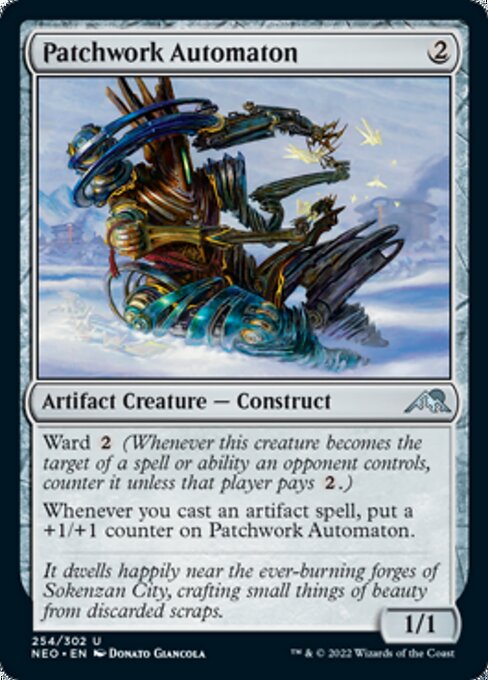
Solid in any red deck, Twinshot Sniper is excellent due to its versatility. Whilst Mono Red may shun four drops in general, the channel ability means this will never rot in your hand. Whilst a two for one is always great, being able to point this at the face is what really pushes this card over the edge.
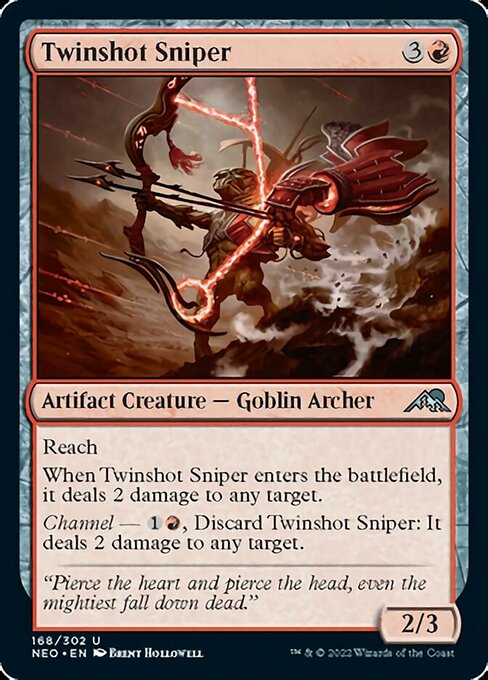
Undervalued by many at first, Kumano Faces Kakkazan, provides an incredible amount of value for just one mana. Whilst the one point of damage amounts to nothing in many decks, here it’s actively pushing our game plan forwards. The +1/+1 counter is nice too and the hasty body helps to mitigate the time taken for it to arrive.
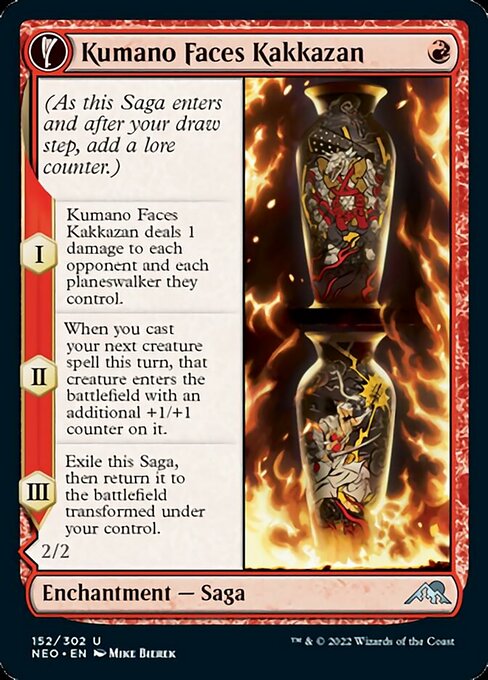
Another great uncommon, Sokenzan Smelter, can upgrade any artifact to a hasty 3/1 body. With no shortage of fodder in red, you will quickly be amassing an army of constructs to overwhelm your opponent.
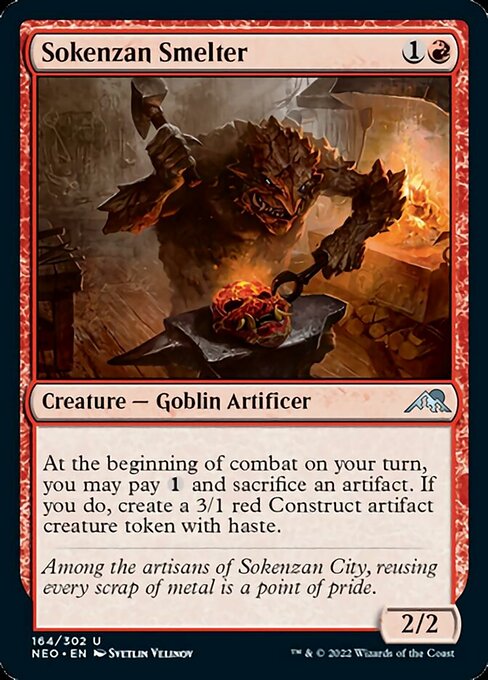
A middling card in the format in general, High-Speed Hoverbike finds its place to shine in Mono Red. This evasive threat can tap down a blocker as it enters the battlefield and, with Crew 1, it's easy to get attacks in.
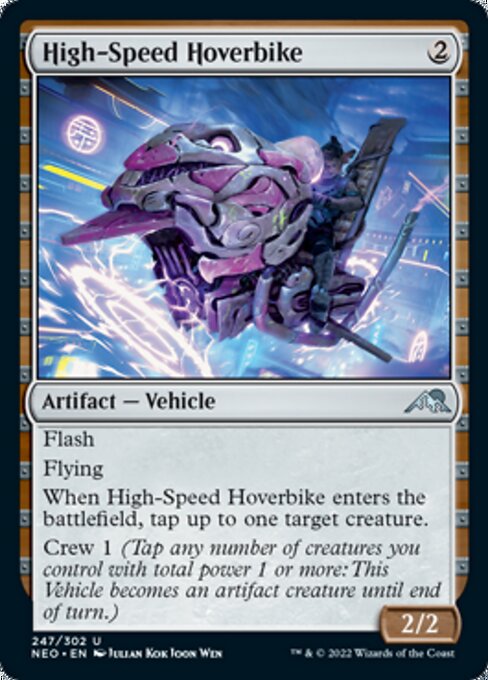
A premium one drop, Rabbit Battery is exactly what this deck needs. Getting in for a few points of damage in the early turns, this can give all your creatures haste later in the game. With a reconfigure cost of just one mana this has efficiency written all over it.
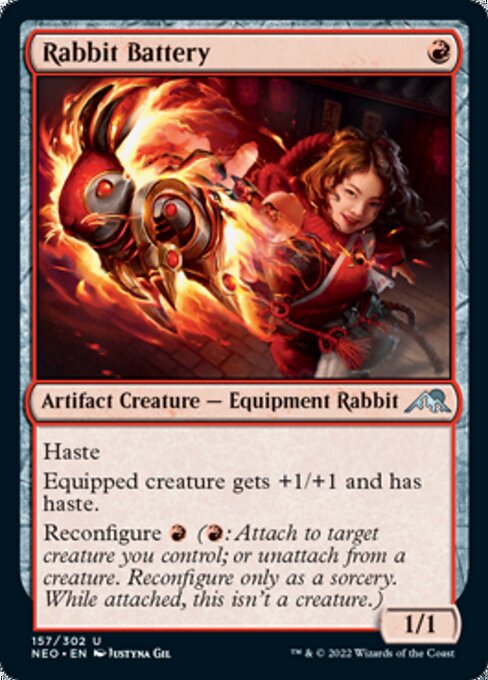
Key Commons
Looking at the red and colorless commons available for this deck, we see that there’s no shortage of playable options.
Players looking for efficient removal will not be disappointed by Voltage Surge. The low cost of this card means you can keep deploying threats even on a turn when you remove a blocker. In addition to that, being able to take down a four toughness creature, makes it tricky for your opponent to stabilize with a single body.
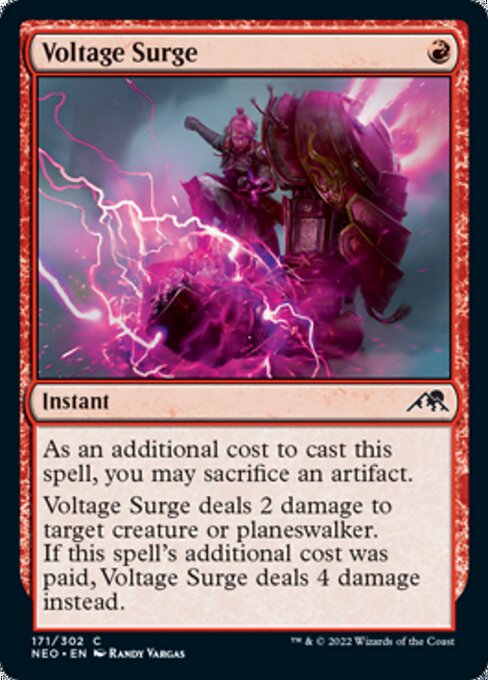
Kami's Flare is another efficient removal spell and one that you will need to pick highly. Given how easy it is to own a modified creature in this archetype, this spell will frequently deal two damage to the face, further advancing red’s plan.
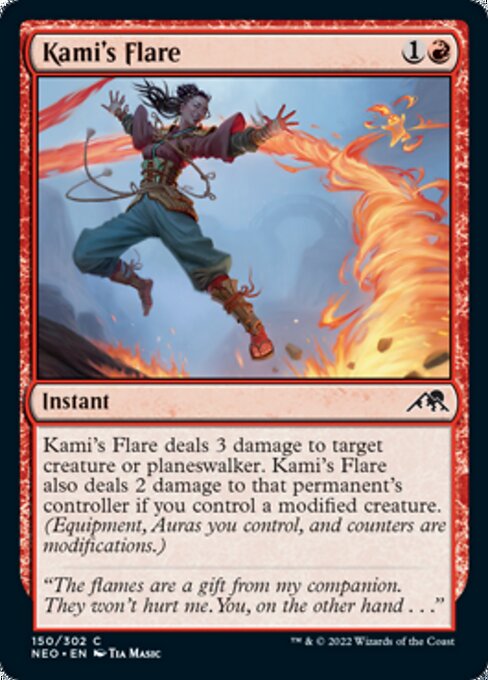
Towashi Songshaper is red’s best common two drop creature. Due to the density of artifacts in this archetype, it can frequently be cracking in for four or even five points of damage. Perfect in multiples, these artifact creatures even trigger each other on entering the battlefield.
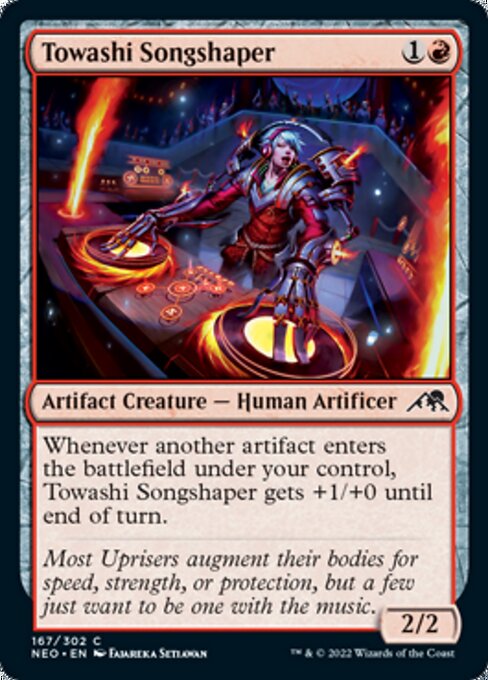
An often underrated card in the format, Iron Apprentice, is perfect in a deck which is hungry for one drops. An artifact creature, it can power up your Patchwork Automaton and Songshapers or be sacrificed to your Sokenzan Smelter. Living on after its death in the form of a +1/+1 counter, this card also provides a modified creature to switch on Kami’s Flare or can be used as a combat trick when sacrificed to Voltage Surge. A glue card for sure, this utility of this little guy is quite astounding for a one mana 1/1.
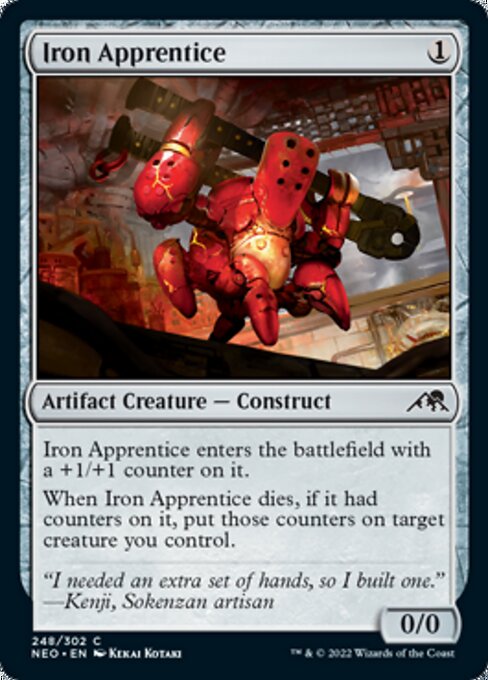
Another key card in the archetype is Experimental Synthesizer. With a few copies of this in your deck, you can ensure that you never run out of steam. Keeping the cards flowing, it enables a low land count and incentives further keeping your curve super lean. This card really does say ‘no’ to four and five mana cards as a brick off the top is so painful.
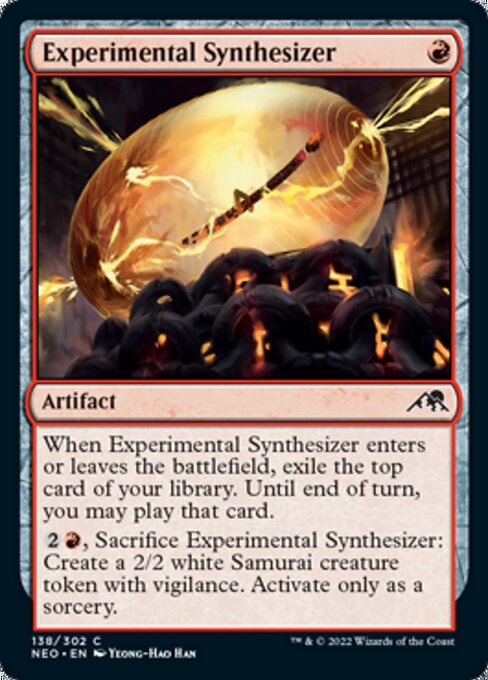
Red’s only one drop creature at common is Simian Sling and as such, it's an auto include. Less powerful than other options, this is still a fairly high pick to ensure a density of early threats.
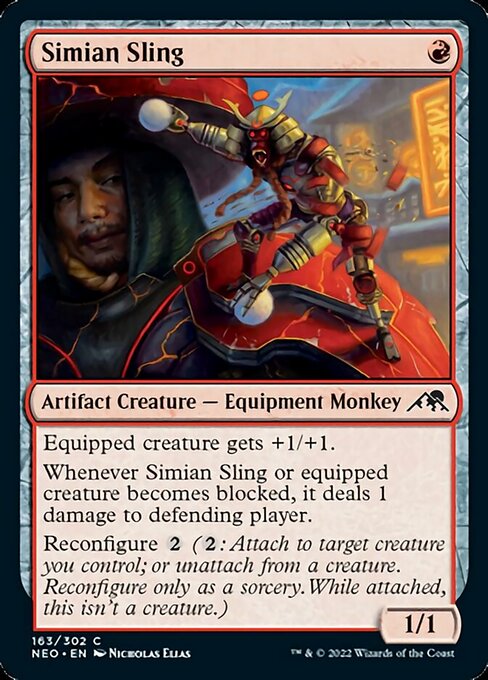
A high powered beater that prevents your opponent from blocking, is exactly what this deck wants. As such Unstoppable Ogre frequently makes the cut despite costing a hefty three mana.
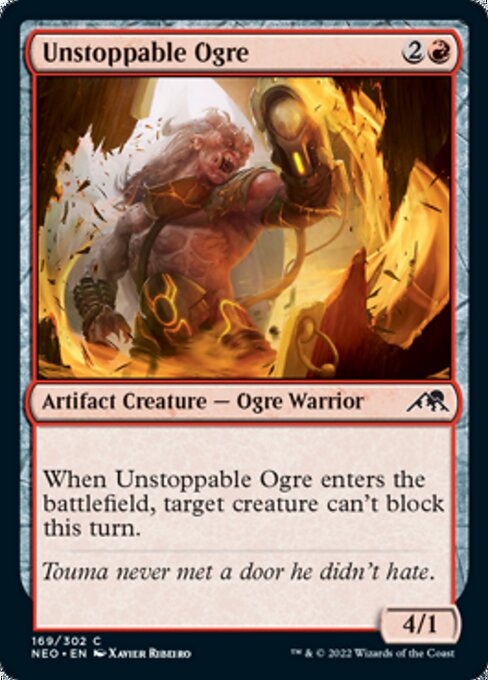
When drafting a mono colored deck it can sometimes be a challenge to make payables. As such, colorless cards often make the grade. Both Searchlight Companion and Papercraft decoy are solid options .The first provides a flying body which can be useful for getting in those last few points of damage. Whilst the second has a type of pseudo evasion in the early game, since your opponents will be reluctant to trade with this, if you have mana open.
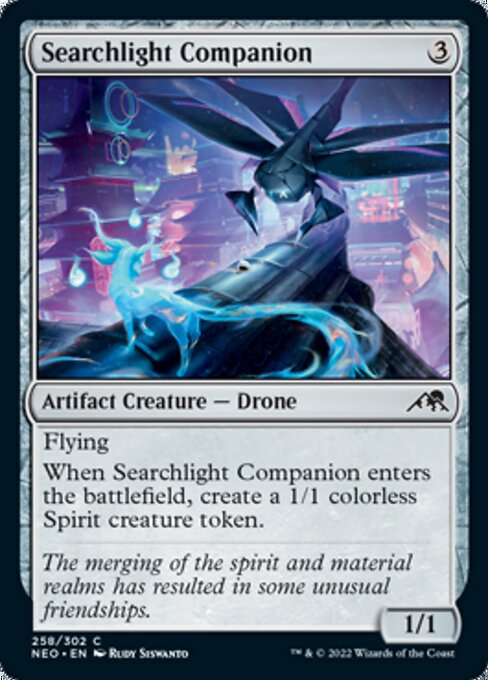
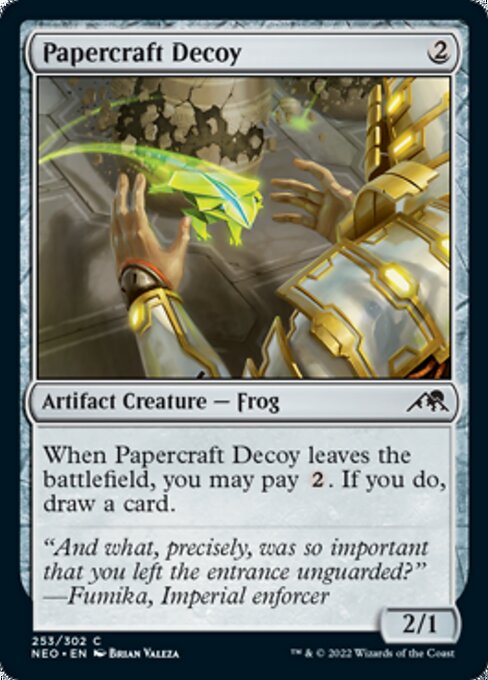
Rares That Pull You In
Like most of the decks in Kamigawa Neon Dynasty, Mono Red Aggro exists primarily at common and uncommon. That said, there are some specific rares that might pull you in this direction.
Thundering Raiju is one such card. A hasty creature that does damage to the face is a natural fit in Mono Red and with double red pips it’s less likely to be taken and splashed elsewhere.
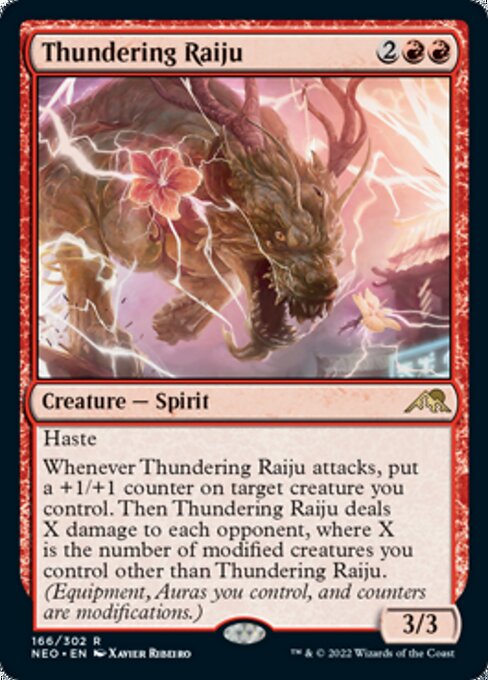
Another great option is Lizard Blades. A powerful two drop, the reconfigure ability allows you to keep pushing through damage or force your opponent to trade down.
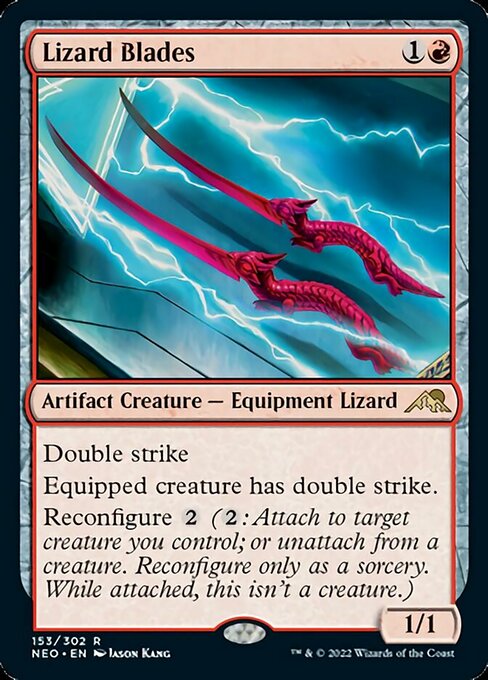
Ogre-Head Helm is another rare that overperforms in Mono Red. Whilst the reconfigure cost is a little pricey, the option to draw three cards from this is extremely powerful and, in a deck dedicated to pushing damage, the trigger isn't hard to obtain.

Trap Cards
Red has several cards to be wary of when drafting. The most common trap that players fall into here, is the inclusion of Dragonspark Reactor. In an ideal world this card comes down on turn two and amasses a bunch of counters before doming your opponent for lethal damage. In practice however this card is slow to get going, vulnerable to disenchant effects and vastly tempo negative when cast. In addition to that, it makes for an absolutely stinking top deck. Better to keep this one in the sideboard.
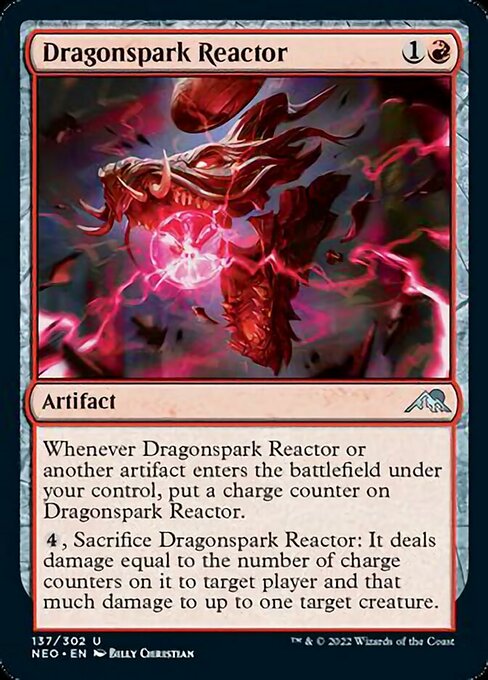
A common card to avoid is Scrapyard Steelbreaker. Whilst not a ‘trap’ exactly, this doesn’t play well in the archetype. Too expensive for a fast curve out, this doesn’t push any damage the turn it enters the battlefield and can be chump blocked easily. In addition to that, it plays very poorly with Experimental Synthesizer. It’s not a total disaster if this makes your deck but definitely one to avoid.
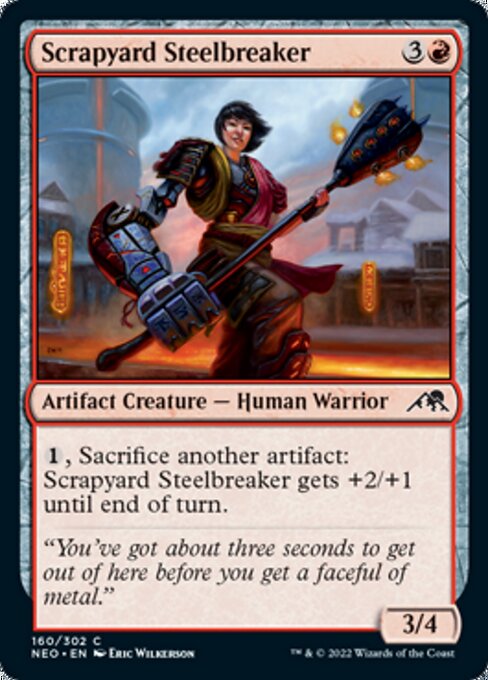
With quad red casting cost, Invoke Calamity might seem like a natural fit in Mono Red Aggro. However, with only two key instants and sorceries on our list (Voltage Sure and Kami’s Flare) the chances of us netting a card with this rare are slim to none.
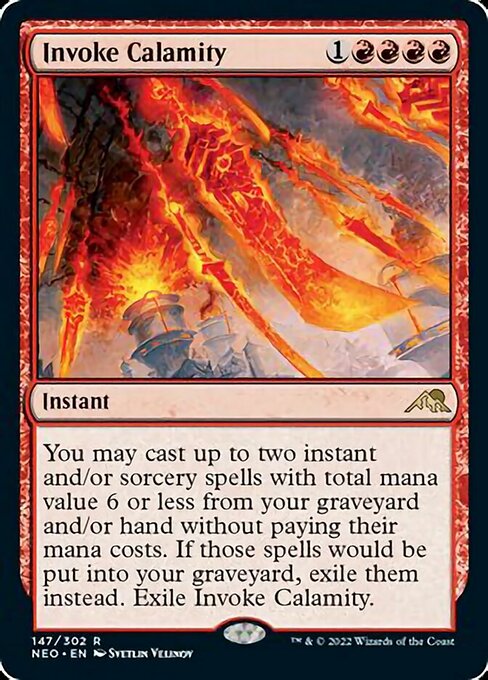
Pivoting Into Rakdos
Whilst pure Mono Red is the most premium version of this deck, sometimes your seat isn't open enough to enable that. Alternatively you may pick up some black cards which are just too good to pass. On these occasions, pivoting into Rakdos Aggro can be a good idea and is relatively simple to do.
The two key black commons for the archetype are Okiba Reckoner Raid and Clawing Torment. Both of these fit well into the archetype as the points of damage inflicted on your opponent contribute well to our game plan. In addition, the menace creature from Reckoner Raid makes it easier to score further points from your opponent whilst Torment removes a blocker for just one mana.
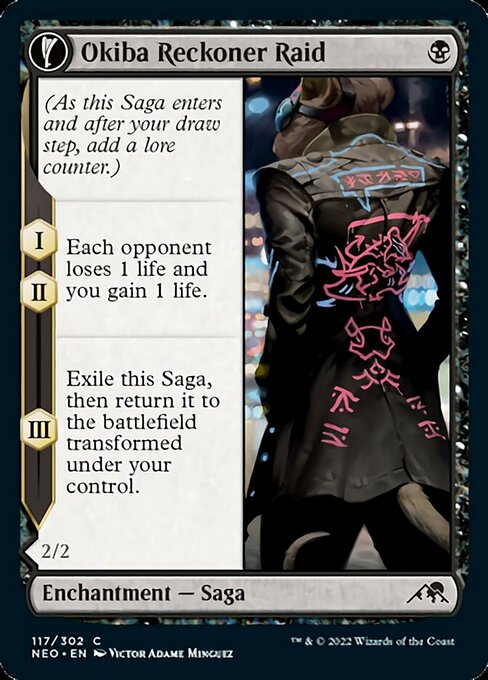
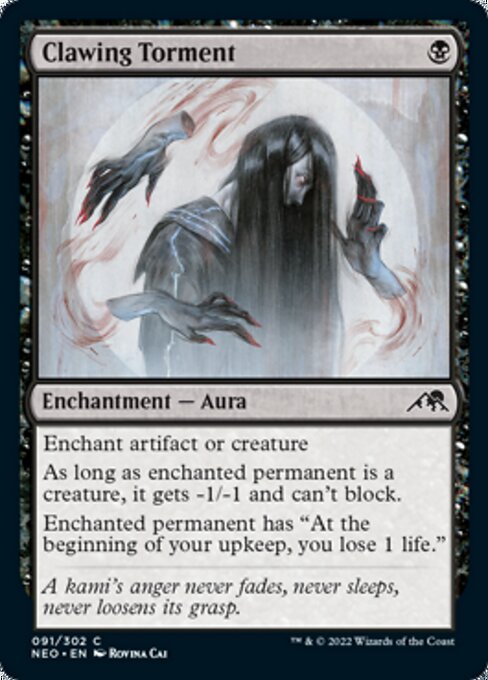
Oni Cult Anvil is a major pull at uncommon into Rakdos. Capable of dealing some serious damage over several turns, it provides a repeatable source of reach. It’s not unusual for your opponent to stabilize the board with just a few points of life remaining and the Anvil ensures you can close out the game.
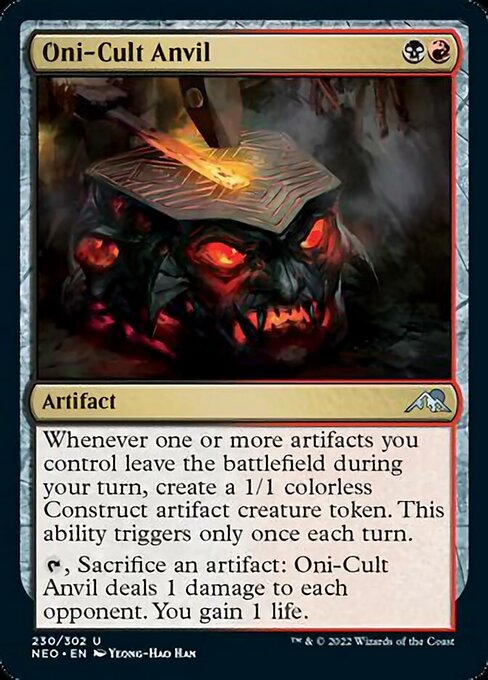
The main disadvantage of running Rakdos vs. Mono Red is the mana base. Due to the color requirements, Rakdos will have to run sixteen or seventeen lands, often with a mana base skewed towards red. Unfortunately this means that the deck will lose more games due to color screw or flood and will be able to present threats less efficiently in general. It's definitely important to weigh up this cost when deciding which version of the deck to run.
Mulligan Decisions
As discussed, Mono Red thrives on early aggression, aiming to steal a win before an opponent can stabilize the board. As such it's crucial to mulligan any hand that doesn’t enable this game plan. Whilst typical advice is to mulligan rarely in Limited, here we should take our chances with one less card rather than holding onto a clunky hand.
For example, a hand without any low drop creatures should be mulliganed even if it contains a reasonable mix of lands and removal spells. It’s also important to mulligan any hand with an excess of land, five and six land hands for instance will rarely get the job done.
Gameplay
As you deploy your hand to the board, it’s crucial to start getting in as many points of damage as possible. When your opponent's board is empty, this is clearly easy. However, if your opponent casts an early creature, don’t be afraid to use a removal spell on it. Clearing early blockers is typically more advantageous than trading off, as this allows damage to be pushed more quickly.
If your opponent misreads the situation and starts attacking you in return then that’s fantastic. There’s no need to keep back blockers or trade pieces off, just keep your pedal to the metal. It's highly unlikely that your opponent will be able to win a race against your streamlined aggro deck.
As the game progresses, you will ideally have your opponent down to just a few points of life. In the best case scenario they are unable to stabilize but more commonly you will find yourself without good attacks. This is where difficult decisions may need to be made. Should you take a suicide run on consecutive turns to try and finish them off? Or do you have a spell in your deck which can reach your opponent's face?
In order to secure the win in this situation, you may need to throw typical magic advice out of the window. All the usual heuristics about not trading down and not giving your opponent a two for one, no longer count. Let’s face it, none of these things will matter a shred once your opponent is dead. In addition, good knowledge of the cards in your deck will be advantageous, allowing you to plan your game around what you might draw off the top.
Example Deck 1
This deck is a fine example of the low curve Mono Red is looking for. With a high number of one and two mana threats, the only cards further up the curve are heavy hitters such as Unstoppable Ogre and Thundering Raiju. Leaning hard into the artifact theme with a Patchwork Automaton and three Towashi Songshapers, this deck is capable of aggressive synergy. In addition, with two experimental synthesizers this deck will rarely run out of juice.
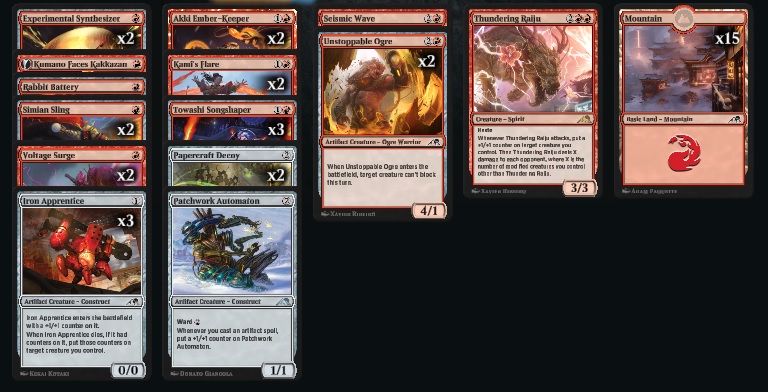
Example Deck 2
In this example, the drafter moved into black for some key commons and a copy of Oni-Cult Anvil. Whilst the power level of these cards can’t be denied, running a higher land count is necessary given the number of one drops in both colors. The risk of mana issues is offset however, by the ‘ping’ effects of the black cards which provide substantial reach. Note also the three drop slot where this deck takes to the skies with three copies of Searchlight Companion providing some additional evasion.
